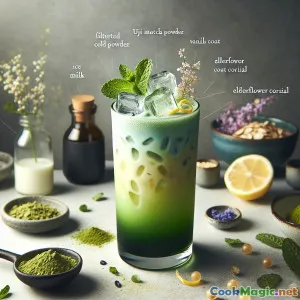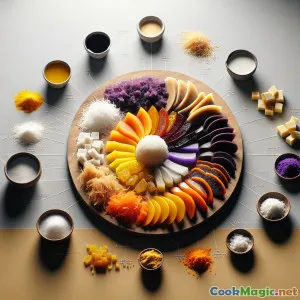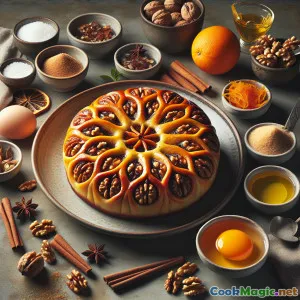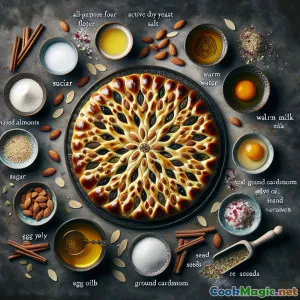
Karanda'y:酸甜英式甜塔的美味享受
(Karanda'y: Tangy English Sweet Tart Delight)
(0 评论)食材
营养
- 份量: 6
- 每份大小: 1片(约150克)
- Calories: 320 kcal
- Carbohydrates: 40 g
- Protein: 5 g
- Fat: 15 g
- Fiber: 4 g
- Sugar: 20 g
- Sodium: 45 mg
- Cholesterol: 120 mg
- Calcium: 60 mg
- Iron: 1.2 mg
制作步骤
-
1 - 准备塔皮面团:
在一个搅拌碗中,混合面粉、一撮盐和40克细砂糖。用指尖或糕点刀将冷藏的黄油切成小方块,直到混合物类似粗碎屑。逐渐加入2-3汤匙冷水,搅拌至成团。将面团塑形成圆盘,用保鲜膜包好,冷藏30分钟(也可以提前开始。)
-
2 - 预烘焙塔皮壳:
将冷藏的面团在撒了少许面粉的平面上擀开,大小刚好适合直径23厘米的塔馅盘。用面团铺好馅盘,按压边缘,用叉子扎底。放入冰箱冷藏10分钟。将烤箱预热至180°C(350°F)。用烘焙纸垫底,加入烘焙重或干豆。烘烤12分钟,取出重物和纸,再烘烤5分钟,直到表面微微金黄。稍微冷却。
-
3 - 准备卡兰达水果馅料:
将新鲜或冷冻的卡兰达水果四分之一与剩余的40克细砂糖和柠檬皮(如使用)放入平底锅中。用中火慢炖5分钟,直到水果略微变软,释放出酸味但仍保持形状。离火后稍微冷却。
-
4 - 混合奶油:
将蛋黄、香草提取物(如使用)和浓奶油一起搅拌至顺滑。慢慢加入温热的卡兰达水果混合物(不包括果汁)以调节卡仕达酱的温度。
-
5 - 组装并烘焙塔:
将水果块均匀地放入预先烘焙的馅饼壳中。将卡仕达酱倒在水果上。以160°C(320°F)烘烤25-30分钟,直到卡仕达酱凝固但中间略微晃动。取出并冷却至室温。
-
6 - 冷却并上菜:
在切片前至少冷藏1小时。冷藏或在室温下食用,可选择撒上细砂糖或加入一勺凝脂奶油。
在一个搅拌碗中,混合面粉、一撮盐和40克细砂糖。用指尖或糕点刀将冷藏的黄油切成小方块,直到混合物类似粗碎屑。逐渐加入2-3汤匙冷水,搅拌至成团。将面团塑形成圆盘,用保鲜膜包好,冷藏30分钟(也可以提前开始。)
将冷藏的面团在撒了少许面粉的平面上擀开,大小刚好适合直径23厘米的塔馅盘。用面团铺好馅盘,按压边缘,用叉子扎底。放入冰箱冷藏10分钟。将烤箱预热至180°C(350°F)。用烘焙纸垫底,加入烘焙重或干豆。烘烤12分钟,取出重物和纸,再烘烤5分钟,直到表面微微金黄。稍微冷却。
将新鲜或冷冻的卡兰达水果四分之一与剩余的40克细砂糖和柠檬皮(如使用)放入平底锅中。用中火慢炖5分钟,直到水果略微变软,释放出酸味但仍保持形状。离火后稍微冷却。
将蛋黄、香草提取物(如使用)和浓奶油一起搅拌至顺滑。慢慢加入温热的卡兰达水果混合物(不包括果汁)以调节卡仕达酱的温度。
将水果块均匀地放入预先烘焙的馅饼壳中。将卡仕达酱倒在水果上。以160°C(320°F)烘烤25-30分钟,直到卡仕达酱凝固但中间略微晃动。取出并冷却至室温。
在切片前至少冷藏1小时。冷藏或在室温下食用,可选择撒上细砂糖或加入一勺凝脂奶油。
关于 Karanda'y:酸甜英式甜塔的美味享受 :的更多信息
Karanda'y: A Unique English Twist on Tangy Fruit Tart
Karanda'y is an inventive English dessert recipe that creatively incorporates the small, tart karanda fruit, which is not traditionally found in English cuisine but imparts a delightful tanginess to the dish. This dessert harmonizes a buttery, flaky tart crust with creamy vanilla custard, topped generously with karanda fruit cooked just enough to soften but retain their texture. The origin of this recipe melds British baking fundamentals with the adventurous introduction of karanda fruit, often enjoyed in South and Southeast Asia, fostering a cross-cultural culinary experience.
History and Cultural Significance
While the karanda fruit has a history steeped in tropical regions where it’s used for jams, relishes, and traditional medicines, this recipe bridges geographic culinary traditions. The English passion for custard-filled pastries like tarts and flans meets an exotic fruit that brightens the palate and counters the richness of cream and butter used in the crust and filling. Karanda'y showcases how global influences shape modern British cuisine, blending local techniques with fresh, new ingredients.
Unique Aspects
Unlike typical English fruit tarts which often rely on berries or apples, Karanda'y delivers a vibrant flavor twist and a visually appealing burst of orange-red fruit nestled within a creamy custard base. The use of karanda is unusual; its tart notes balance the custard perfectly and encourage a complex flavor profile that is both refreshing and comforting.
Preparation Tips
To successfully highlight the unique flavor of karanda, use fresh or good-quality frozen fruit when fresh is unavailable. The tart dough benefits from chilling and a gentle blind baking to avoid sogginess. The custard should be poured cautiously over the fruit to prevent scorching and to allow even baking without curdling.
For an extra touch, finishing the tart with a light dusting of powdered sugar or a side of clotted cream accentuates the comforting luxury of English desserts while respecting the fruit’s sharpness.
Serving and Pairing
Karanda'y is perfect served at teatime or as a light dessert after a hearty meal, ideally accompanied by mild tea varieties or a subtle sparkling wine which echoes the fruit's fresh acidity. The recipe is well suited for spring and summer when fresh fruit is best.
Personal Thoughts
Creating Karanda'y provided an enjoyable challenge to blend flavors from disparate culinary backgrounds while respecting each element’s role in the overall dish. It's a reminder that exploring global ingredients can revitalize classic recipes, sparking new food stories that connect people through taste.
By embracing a less common fruit and giving it center stage in an English tart format, Karanda'y becomes not only a dessert but a narrative of culinary curiosity, fusion, and tradition reinvented.

























